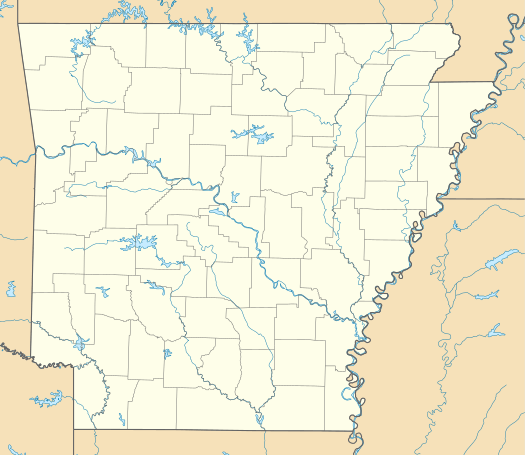Fort Southerland
Fort Southerland, also known as Redoubt E, is a defensive fortification erected during the American Civil War on what was then the outskirts of Camden, Arkansas. The oval earthworks are now the centerpiece of a city park off Bradley Ferry Road on the east side of the city. It was listed on the National Register of Historic Places in 1994, and, with other sites, is part of the Camden Expedition Sites National Historic Landmark.[2][3][4]
Fort Southerland | |
 | |
  | |
| Location | Camden, Arkansas |
|---|---|
| Coordinates | 33°34′26″N 92°49′05″W |
| Area | 6 acres (2.4 ha) |
| Built | 1864 |
| NRHP reference No. | 94001184 |
| Significant dates | |
| Added to NRHP | April 19, 1994[1] |
| Designated NHL | April 19, 1994[2] |
Description
Fort Southerland was the southernmost of a chain of five redoubts built by Confederate forces and slave labor in 1864 to protect the city from attack by Union forces located to the north and east. The oval-shaped earthworks are about 2,000 feet (610 m) by 1,000 feet (300 m), and were capable of holding three guns. The redoubt provided defensive coverage over Bradley Ferry Road, which was the main road to other Confederate holdings in Warren and Monticello, and cover against the remote possibility that Union forces would cross the Ouachita River below the city. At the time of its construction Camden was much smaller, and the redoubt was located well outside the urban center. Of the five redoubts built, this one is the best-preserved; only one other, Fort Lookout or Redoubt A, survives in any significant form, and is also included in the National Historic Landmark designation.[5]
History
Brigadier General General Alexander T. Hawthorn, a Camden native, had been given the task of organizing the city's defenses. From January to March Confederate troops and slave labor worked to develop a series of five redoubts, mainly to protect the southern and western land-based approaches to the city. Union Major General Frederick Steele, in command of the forces occupying Little Rock, was ordered to move southwest to effect a junction with Major General Nathaniel Prentice Banks' Red River Campaign, a push to take Shreveport, Louisiana and eventually gain a Union foothold in Texas. Steele's force left Little Rock on March 23, 1864, passing through thinly-populated southwestern Arkansas. His advance was blunted at the Battle of Prairie D'Ane (April 9–13). Needing provisions, Steele ordered his forces to march on Camden, which they occupied on April 15 after it was abandoned by its small number of defenders. During the Union's brief (ten-day) occupation, the defenses were expanded with additional trenches and earthworks. Steele was prompted to reconsider the continued occupation of Camden after supply-related initiatives were set back at Poison Spring (April 18) and Marks' Mills (April 25), and withdrew from Camden toward Little Rock on April 26.[5]
Camden's defenses were further expanded after Confederate forces reoccupied the city. A weak point that was known to both sides, the waterfront area, was fortified in October 1864. By the end of the year a complete trench line encircled the city.[5]
See also
References
- "National Register Information System". National Register of Historic Places. National Park Service. January 23, 2007.
- "Camden Expedition Sites". National Historic Landmark summary listing. National Park Service. 2007-09-26. Archived from the original on 2007-03-01.
- Bearss, Edward C.; Charleton, James H. (November 29, 1993). "National Historic Landmark Nomination: Camden Expedition Sites" (pdf). National Park Service.
- "National Register of Historic Places Inventory-Nomination: Camden Expedition Sites—Accompanying photos" (pdf). National Park Service. 1993.
- "NHL nomination for Fort Southerland" (PDF). Arkansas Preservation. Retrieved 2014-05-24.